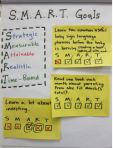 So far, this series has included…
So far, this series has included…
- Classroom procedures that help students explore and construct problem-solving strategies.
- Ways to make sure your low readers and second language students are not at a disadvantage.
Is there a perfect Problem Solving teaching resource?
Bad news: Instructional materials are only as good as the instructor. More bad news: Materials from the major textbook companies will probably not be adequate – even if their representatives tell you otherwise.
In 2003 and 2007, two representatives of a major textbook company tried to convince me that the problem solving activities attached to the summative assessments were adequate in helping students develop problem-solving skills. My first issue: One problem solver per unit means that students get 12 opportunities during the year to build these skills. Students need more than that. My second issue: Students have had no scaffolding throughout the unit that would make them successful.
Students turned in their assessments with looks of shame and defeat.
One representative claimed there was research defending the position that problem solving strategies need not be explicitly taught. Given enough time, students will develop strategies on their own.
I have scoured the research. Can’t find it. The only research I can find post-millenium states that students with disabilities benefit from explicit, repeated instruction.
Look for materials that explicitly teach strategies.
If students are going to transfer problem solving skills to real-world problems in a different context, Grant Wiggins suggests students must make four cognitive moves:
- independently realize what the question is asking and think about which answers/approaches make sense;
- infer the most relevant prior learning from plausible alternatives;
- try out an approach, making adjustments as needed given the context or wording; and
- adapt their answer, perhaps, in the face of a somewhat novel or odd setting
Students must have a mental portfolio of plausible, alternative approaches. Without a mental portfolio of possible strategies, elementary students will tend to do one of the following:
- randomly add, subtract, multiply, or divide numbers – hoping they pick the right operation.
- tell you they are using the “guess and check” method. Their paper will full of random computational guesses. One of the guesses will be circled.
If you spend at least a few lessons each year explicitly working with and repeating strategies, students have a mental portfolio of approaches from which they can draw.
Give them a chance to explore one type of problem using the procedures I outlined in the first part of this series. Give them a similar problem the next day. Then give them a homework assignment using that strategy. The fourth time, almost all students can independently use the strategy.
…but don’t name the strategies.
In the next entry, I’ll get on my proverbial soapbox about the “pick a strategy” step in the frequently-published ‘problem solving process.’ Rather than say, ‘This kind of problem is solved by [name the strategy]’, you still want students to construct a strategy or two that works.
When students find something that works and defend their strategy, then you want them to solidify the conceptual understanding in different (but similar) problems.
Who cares what they call it? If students are going to name things, ask them to connect vocabulary from other math strands to the patterns they are finding.
Collect the strategies in a journal, notebook, or portfolio.
Math journals help students keep a record of previous lessons. Some of the best journals I’ve seen are found at Runde’s Room.
During a lesson where a new strategy is introduced, expect the journal pages will be rather messy. The students will start well, including sketches and bullet points showing their understanding of the scenario and the question. Then, to construct meaning, students need to try different things, collaborate with classmates, change approaches, then collaborate some more. They will cross things out. They will erase until the page tears (although I discourage erasing). They will repair pages with scotch tape. They will use white-out strips. They will circle things and use arrows when explaining work to others. This is a good thing.
The second day, students will get to an answer more directly because they can refer to the procedures that worked the day before and apply them in the new and different situation.
The homework that follows might be given as a worksheet. Rather than collecting the homework for grading, have students take the work out at the beginning of the lesson, compare their answers in small groups, and come to consensus.
If changes need to be made, students can make the changes in a different color pencil. Then, students write a short “things to remember” note and paste the homework in their journal.
Wean students off of the repetition.
At some point, the types of problems should spiral more than repeat. Questions for students: Does this problem resemble any you’ve seen before? How does it relate to prior knowledge in other areas of mathematics?
Some will benefit from looking back at the journal for ideas. Others will not need that step.
Remember that not all the students will need repetitions of strategies.
Once a student demonstrates the ability to independently use a strategy, there is no reason to give him or her more of the same. You will have students that catch on the first time and immediately apply the strategy to new situations. These students will be held back if you require them to have them do the same problems as the rest of the class.
Try giving these students a problem that is at least a grade level higher. Assuming the student has no trouble with that, move him/her on to a project.
What materials help teach problem solving strategies?
I’ve had the best luck with The Problem Solver – with reservations that I will explain in the fourth part of this series.
The real power of the Problem Solver comes when teachers can match Problem Solving strategies with the conceptual ideas of a mainstream curriculum math unit. Some examples:
- Students need to find all the factors of numbers. They learn the Rules of Divisibility and continually ask themselves Is 1 a factor? Is 2 a factor? Is 3 a factor? This unit provides a great opportunity for the strategy ‘Make an organized list’. In both situations, students need to think about and organize numbers in a more systematic way.
- You are teaching a unit on fractions. Fractions combine well with the ‘Working
backward’ strategy.
- If students are learning to graph coordinates on a plane, they might also practice ‘Make a picture or diagram’.
Mathematical strands that tend to match Problem Solving strategies.
Think of problem solving as an umbrella that covers all the mathematical strands.
No hard and fast rules exist to match problem solving with other mathematical strands – only experience will help you make the matches. Also, problem-solving strategies overlap. Many students begin a problem with a picture or diagram. Why stop there? An organized list might lead to a pattern that can be graphed. Celebrate when students find the overlaps!
If you’re new to a mathematics series or to problem solving instruction, here are some general guidelines:

Conclusion
Find a set of materials that explicitly teach problem solving strategies. Teach the strategies for a decent chunk of the year. Don’t rely on teaching strategies the whole year, but give students enough background knowledge and confidence that they can approach a scenario with a few tried and true options.
Do not force repetition on all your students because some will not need it. An initial problem or a pre-assessment might be the same but the follow-up problems need not be.
Connect the strategies with other mathematical strands.
Have you found any research on the pros and cons of teaching strategies? What materials have you found that help teach problem solving? Please share!
If you like what you read, please subscribe to Expat Educator. You’ll have instant access to subsequent posts in this series. The next post: What the Problem Solving Process is Missing.
photo credit: Marquette La via photopin cc





















